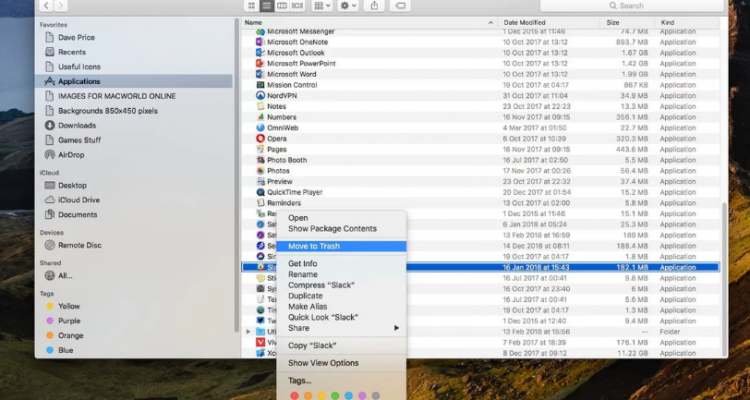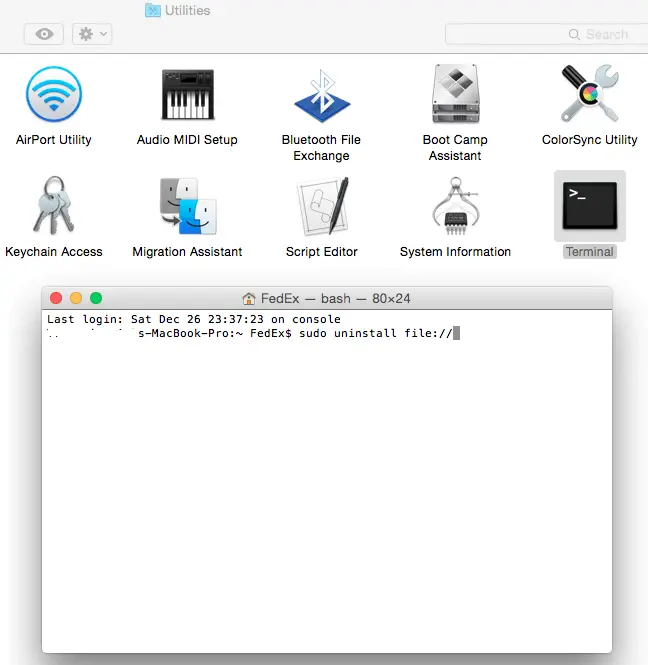- For apps downloaded from the Mac App Store, just go to Launchpad by clicking the icon in the Dock or pinching the thumb and three fingers together on the Trackpad. Find the app you want to remove, hold down its icon until you see it jiggles, then hit the “X” button to delete it.
- How To Uninstall Apps On Mac OS X Using The Command Line Most of users don’t like to use commands in Terminal to do anything because those commands are not easy to remember. They feel not comfortable and will look for solutions which easier to do, such as an app with a friendly and simple user interface.
- How To Uninstall Honey App On Mac
- How To Uninstall On A Mac
- How To Uninstall Apps On Mac Terminal
- How To Uninstall Apps On Mac Terminal Download
Terminal User Guide
Each window in Terminal represents an instance of a shell process. The window contains a prompt that indicates you can enter a command. The prompt you see depends on your Terminal and shell preferences, but it often includes the name of the host you’re logged in to, your current working folder, your user name, and a prompt symbol. For example, if a user named michael is using the default zsh shell, the prompt appears as:
This indicates that the user named michael is logged in to a computer named MacBook-Pro, and the current folder is his home folder, indicated by the tilde (~).
From the Finder go to the Applications folder. Look for the Cisco folder and open it; Then double click on Uninstall Anyconnect to start the uninstall process; Follow instructions to uninstall VPN program; Here's the procedure for manually uninstalling the AnyConnect client from a Mac OS X system. As root, run the following shell script from. In order to remove the Apps in Mac, you only have to open the application folder and drag the app to the Bin or Trash Can. This is rather easy if the program is uninstalled simply. However, if the application still denies to uninstall and stays on the Mac then we need to get another solution below. From the /Applications folder, I can launch apps on my Mac using the open command in the terminal like this. Open xcode.app open firefox.app Is there a way to delete apps from the terminal? This question/answer doesn't provide the answer to this question. Macs also have no way to uninstall or install operating system features, so there’s no way to easily remove the many applications Apple included with your Mac. On OS X 10.10 Yosemite and earlier, it was possible to open a terminal window and issue commands to delete these system apps, which are located in the /Applications folder. Best ways to delete apps on Mac. As lots of programs leave their support files all over your Mac (and it’s hard to tell which ones do or don’t), it’s important to uninstall applications on Mac completely and not just delete them from the Applications folder. To do that, you need a software like CleanMyMac X.
Open Terminal
On your Mac, do one of the following:
Click the Launchpad icon in the Dock, type Terminal in the search field, then click Terminal. Best mac apps tweaks windows 10.
In the Finder , open the /Applications/Utilities folder, then double-click Terminal.
Quit Terminal

In the Terminal app on your Mac, choose Terminal > Quit Terminal.
Quit a shell session
In the Terminal app on your Mac, in the window running the shell process you want to quit, type
exit, then press Return.
This ensures that commands actively running in the shell are closed. If anything’s still in progress, a dialog appears.
How To Uninstall Honey App On Mac
If you want to change the shell exit behavior, see Change Profiles Shell preferences.
Another solution, which is best reserved for and intended for use by advanced Mac users only who are comfortable with the command line and have a deeper knowledge of OS X, is the thorough manual removal of an app and all associated components, and that’s what we’ll cover here.
This process method is much more technical, and relies on the terminal to accomplish the complete uninstall procedure. Again, this is intended for advanced users only, and it is rarely necessary to remove an app or application components this way. We’ll break the steps into a few parts, first will be finding the app and related components, which requires some level of knowledge and discretion to determine what is related and what is not, and second, the actual removal of the appropriate files. If you’re an expert user who is very comfortable with this prospect and you just want some actionable command without any explanation as to what’s going on and why, you can jump to a condensed version below.
How to Find All Components of Apps / Software in Mac OS X

We’ll use Terminal and mdfind, though other command line search tools can also work for this purpose. The general syntax to use is the following command with the -name flag*:
mdfind -name 'application name'
*You can also use the broadest possible search without the -name flag but your results may be less accurate, whether that’s useful is up to you
For example, to find associated files and components with Teleport, the OS X keyboard and mouse sharing utility for controlling multiple Macs with a single keyboard, you could use the following:
File shredder mac app software. mdfind -name 'teleport' Best mac video apps.
This broad search should return everything on the Mac that is associated with the name of the application – this does not mean you should delete everything returned by the search though. Carefully example everything that is found, you may need to adjust your search parameters to determine if you’re finding all the necessary components of the application and/or software.
Generally speaking, you’re looking for binaries, the .app files, and remnant pieces of the software, like plist files, preferences, caches, daemons, and other accessory files and components associated with many apps in OS X. Application components may appear in a wide variety locations, including but not limited to the following file paths:
To reiterate, this may or may not be a full list of where related files are stored for a given application, this is why it’s important to pay attention to what is reported by the mdfind command. If what you’re looking to completely uninstall is a command line utility, it may have components in a variety of binary folders, whether /usr/bin /usr/sbin or others,
Completely Removing Apps & Remnant Application Components
Remove only the related files that are appropriate to delete, there is no universal answer to this which is why you need to pay attention to the files that are found through mdfind utility. Be sure you know exactly what file it is that you are deleting and why you are deleting it – as mentioned already, this is really intended for expert users with advanced knowledge of OS X – you don’t want to accidentally remove the wrong thing. You can then permanently delete the files with either the rm or srm command, if you’re not familiar with the rm command, it’s not reversible, so use with caution or you could unintentionally delete something important.
How To Uninstall On A Mac
If you’re not incredibly confident in what you’re doing, you should at least back up the Mac before going any further, which is a good idea to do regularly anyway.
Here’s an example of the rm with a sudo prefix to allow for administrative privileges, removing some fictitious files at imaginary locations (yes, these are made up to prevent copy/pasting and misuse of the ridiculously powerful rm command):
Again this is an example, the 'sudo rm -rif' component is real but none of the directories or files are, it's going to completely depend on what you find with mdfind and what you determine should be removed.
How To Uninstall Apps On Mac Terminal
Manual App & Component Removal in OS X via Terminal: The Condensed Version
Impatient? Command line expert and know exactly where to find junk? Here's the condensed version, sans explanation - don't jump to this if you don't know what you're doing:
- Trash the known application files
- Launch Terminal and use the following syntax to find remnant components
- Remove associated files from system locations with rm:
- Repeat as necessary with associated component files returned by mdfind
mdfind -name [application name]
sudo rm -rf /Whatever
You can also choose to remove the components from the GUI with the Finder. remove default software that comes bundled with OS X, though without a very compelling reason to do so, that is not recommended.
How To Uninstall Apps On Mac Terminal Download
If any of this seems over your head, it's because this is really much more advanced than what an average Mac user would ever need to do it. For the vast majority of Mac users, it's best to resort to a more traditional app uninstall methods, or use a thorough application uninstaller utility like AppCleaner, which is free and basically does the same search process but through an automated graphical user interface.